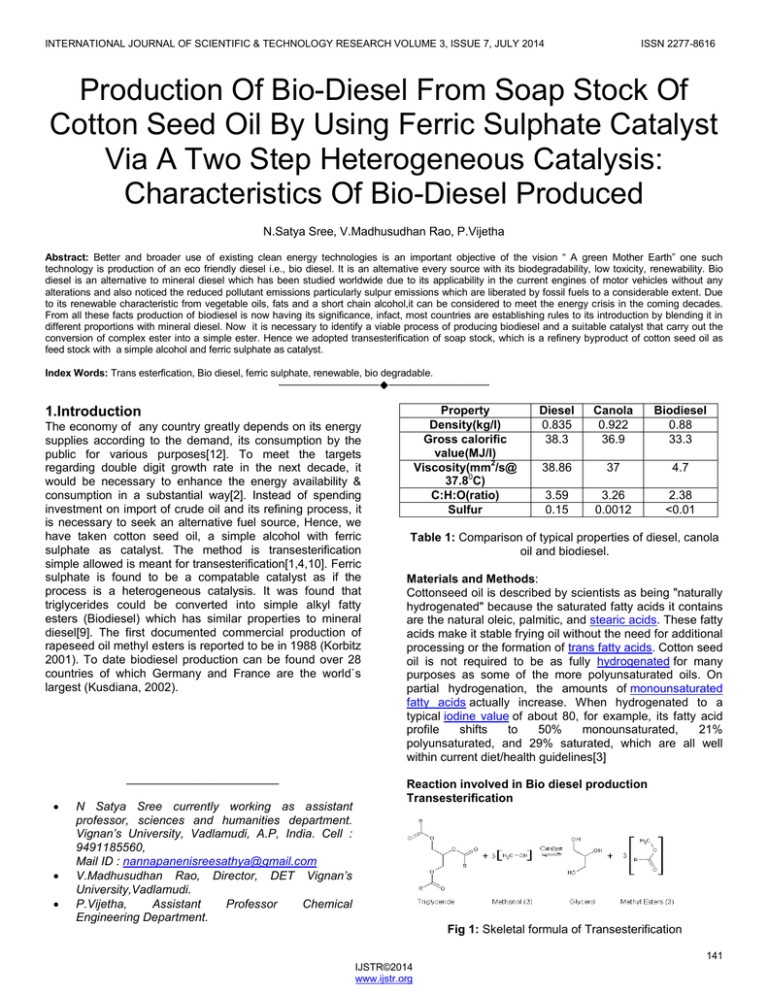Production Of Bio-Diesel From Soap Stock Of Cotton Seed Oil By
advertisement

INTERNATIONAL JOURNAL OF SCIENTIFIC & TECHNOLOGY RESEARCH VOLUME 3, ISSUE 7, JULY 2014 ISSN 2277-8616 Production Of Bio-Diesel From Soap Stock Of Cotton Seed Oil By Using Ferric Sulphate Catalyst Via A Two Step Heterogeneous Catalysis: Characteristics Of Bio-Diesel Produced N.Satya Sree, V.Madhusudhan Rao, P.Vijetha Abstract: Better and broader use of existing clean energy technologies is an important objective of the vision ― A green Mother Earth‖ one such technology is production of an eco friendly diesel i.e., bio diesel. It is an alternative every source with its biodegradability, low toxicity, renewability. Bio diesel is an alternative to mineral diesel which has been studied worldwide due to its applicability in the current engines of motor vehicles without any alterations and also noticed the reduced pollutant emissions particularly sulpur emissions which are liberated by fossil fuels to a considerable extent. Due to its renewable characteristic from vegetable oils, fats and a short chain alcohol,it can be considered to meet the energy crisis in the coming decades. From all these facts production of biodiesel is now having its significance, infact, most countries are establishing rules to its introduction by blending it in different proportions with mineral diesel. Now it is necessary to identify a viable process of producing biodiesel and a suitable catalyst that carry out the conversion of complex ester into a simple ester. Hence we adopted transesterification of soap stock, which is a refinery byproduct of cotton seed oil as feed stock with a simple alcohol and ferric sulphate as catalyst. Index Words: Trans esterfication, Bio diesel, ferric sulphate, renewable, bio degradable. ———————————————————— 1.Introduction The economy of any country greatly depends on its energy supplies according to the demand, its consumption by the public for various purposes[12]. To meet the targets regarding double digit growth rate in the next decade, it would be necessary to enhance the energy availability & consumption in a substantial way[2]. Instead of spending investment on import of crude oil and its refining process, it is necessary to seek an alternative fuel source, Hence, we have taken cotton seed oil, a simple alcohol with ferric sulphate as catalyst. The method is transesterification simple allowed is meant for transesterification[1,4,10]. Ferric sulphate is found to be a compatable catalyst as if the process is a heterogeneous catalysis. It was found that triglycerides could be converted into simple alkyl fatty esters (Biodiesel) which has similar properties to mineral diesel[9]. The first documented commercial production of rapeseed oil methyl esters is reported to be in 1988 (Korbitz 2001). To date biodiesel production can be found over 28 countries of which Germany and France are the world`s largest (Kusdiana, 2002). _______________________ N Satya Sree currently working as assistant professor, sciences and humanities department. Vignan’s University, Vadlamudi, A.P, India. Cell : 9491185560, Mail ID : nannapanenisreesathya@gmail.com V.Madhusudhan Rao, Director, DET Vignan’s University,Vadlamudi. P.Vijetha, Assistant Professor Chemical Engineering Department. Property Density(kg/l) Gross calorific value(MJ/l) Viscosity(mm2/s@ 37.80C) C:H:O(ratio) Sulfur Diesel 0.835 38.3 Canola 0.922 36.9 Biodiesel 0.88 33.3 38.86 37 4.7 3.59 0.15 3.26 0.0012 2.38 <0.01 Table 1: Comparison of typical properties of diesel, canola oil and biodiesel. Materials and Methods: Cottonseed oil is described by scientists as being "naturally hydrogenated" because the saturated fatty acids it contains are the natural oleic, palmitic, and stearic acids. These fatty acids make it stable frying oil without the need for additional processing or the formation of trans fatty acids. Cotton seed oil is not required to be as fully hydrogenated for many purposes as some of the more polyunsaturated oils. On partial hydrogenation, the amounts of monounsaturated fatty acids actually increase. When hydrogenated to a typical iodine value of about 80, for example, its fatty acid profile shifts to 50% monounsaturated, 21% polyunsaturated, and 29% saturated, which are all well within current diet/health guidelines[3] Reaction involved in Bio diesel production Transesterification Fig 1: Skeletal formula of Transesterification 141 IJSTR©2014 www.ijstr.org INTERNATIONAL JOURNAL OF SCIENTIFIC & TECHNOLOGY RESEARCH VOLUME 3, ISSUE 7, JULY 2014 Material balance: Soap stock contains the following fatty acids. i.Palmitic Acid ii.Stearic Acid iii.Oleic Acid iv.Linoleic Acid composition is - palmitic 20.1%, stearic 2.6% oleic acid 19.2%, Linoleic 55.2%. Molecular Weight of palmitic acid = 256.42 g/gm-mole Molecular Weight of stearic acid = 284.4 g/gm-mole Molecular Weight of oleic acid = 282.52 Molecular weight of Linoleic acid = 280.45 g/gm-mole Average molecular weight of soap stock = ∑MiXi Trail no 1 =(256.42x0.085)+(284.4x0.06)+(282.52x0.561)+(280.43x0.26) = 270.26 2 3 Molecular Weight of Methanol = 32 g/gm-mole Molecular weight of glycerol = 92 g/gm-mole Let ‗X‘ be the amount of Biodiesel formed 4 X = 274.26 g Raw material (gm) Soap stock 25 Soap stock 50 Soap stock 75 Soap stock 100 Sol ve nt (ml ) 15 30 45 60 ISSN 2277-8616 Cata lyst (gm) 0.5 1.0 1.39 1.5 270.26 g of oil reacts with 96 g of methanol and forms 274.26 g of biodiesel and 92 g of glycerin. Density of Methanol = 0.791 g/ml Volume of methanol required = 121 ml 5 Procedcedure 1. Conversion of soap stock to bio – diesel using solid ferric sulfate catalyst 2. The mixture is then cooled and left to settle to separate into two layers. a. The mixture is then cooled and left to settle to separate into two layers. b. The upper layer is the bio – diesel and lower layer is un reacted triglycerides with insoluble catalyst that is recovered. 3. The time of processing is taken 4 hours 6 Results and discussions 7 Experimental Results Raw material: Soap stock (gm) Solvent: Methanol (ml) Catalyst: Ferrous Sulphate (gm) 135 Soap stock 175 Soap stock 200 81 105 120 2.02 5 2.62 5 3.0 Result Two phases were obtained; one is honey coloured and another is brown in colour Two phases were obtained; one is honey coloured and another is brown in colour Two phases were obtained; one is honey coloured and another is brown in colour Two phases were obtained; one is honey coloured and another is brown in colour Two phases were obtained; one is honey coloured and another is brown in colour Two phases were obtained; one is honey coloured and another is brown in colour Two phases were obtained; one is honey coloured and another is brown in colour Table 2: Experiment feed details 142 IJSTR©2014 www.ijstr.org INTERNATIONAL JOURNAL OF SCIENTIFIC & TECHNOLOGY RESEARCH VOLUME 3, ISSUE 7, JULY 2014 ISSN 2277-8616 Effect of solvent on product: The effect of solvent is given in figure 2 and table 3.When solvent has significant effect on product resulting in 85% and their onwards no applicable effect [1-4].With every trail increase the volume of solvent by 15 ml. It is found that for 6th and 7th trails though volume of solvent is differed by 15 ml ,there is constancy in yield of product. Trail No 1 2 3 4 5 6 7 Solvent (ml) 15 30 45 60 80 105 120 Product (ml) 8 16 24 44 60 85 85 Fig3: Effect of catalyst on product Effect of time on product: The effect of time is given in figure 4 and table 5.When time has significant effect on product resulting in 85% and their onwards not applicable effect [1-5].Maximum yield is reported at 3.5 hrs after that there is no significant change though the time is forwarded further for 30 minutes. Table 3: Effect of time on product Trail no 1 2 3 4 5 6 7 Reaction time (hr) 0.75 1.5 1.7 2.0 2.7 3.5 4 Product (ml) 8 16 24 44 60 85 85 Table 5: Effect of time on product Fig2: Effect of solvent on product Effect of amount of catalyst on product: The effect of catalyst is given in figure 3 and table 4.When catalyst has significant effect on product resulting in 85% and their onwards not applicable effect. [5-10] though it is raised from 2.625 gm to 3.0 gm. Trail no 1 2 3 4 5 6 7 Catalyst (gm) 0.5 1.0 1.39 1.5 2.025 2.625 3.0 Product (ml) 8 16 24 44 60 85 85 Table 4: Effect of catalyst on product Fig4: Effect of time on product Effect of Raw material on product: The effect of Raw material is given in figure 5 and table 6.When Raw material has significant effect on product results. The yield of bio diesel is maximum with an amount of 200 gm of soap stock . 143 IJSTR©2014 www.ijstr.org INTERNATIONAL JOURNAL OF SCIENTIFIC & TECHNOLOGY RESEARCH VOLUME 3, ISSUE 7, JULY 2014 Trail No 1 2 3 4 5 6 7 Raw material (gm) 25 50 75 100 135 175 200 Product (ml) 8 16 24 44 60 85 90 ISSN 2277-8616 Optimization of process conditions. Optimization of production cost. Conclusion: The Characteristics of Bio-diesel obtained by this process are as per ASTM standards. The pollutants released by it are comparatively less than petro diesel. The feed stock is available from vegetable oil refineries. So production of biodiesel from soap stock is a viable process in the way of creating renewable energy source for the coming days to get out of energy crisis. Table 6: Effect of raw material on product BIBLIOBRAPHY: Fig5: Effect of raw material on product Characteristics of Bio-Diesel: The following properties of Bio – diesel are studied in the laboratory with the aid of Redwood viscometer, Pensky Marten‘s open up cup apparatus , Conradson‘s apparatus and other qualitative and quantitative analytical methods. Quality of bio diesel is determined from its acid value and iodine value. Carbon and sulpuhr emissions are far less than mineral diesel. Cetane number is almost nearer to that of mineral diesel. Carbon residue is measured % by mass which is 30-50% less than mineral diesel. For purity determination of purity HPLC or GC analysis can also be used. S.NO. 1 2 3 4 5 6 7 8 9 10 11 Parameter Density at 15oc(gm/cc) Viscosity at 40 0c(mm2/sec) Flash point (0c) Neutralization number (mg KOH/gm) Conradson carbon residue (%) Mono glyceride(%mass) Diglyceride(%mass) Tri glyceride(%mass) Free glyceride(%mass) Total glyceride(%mass) Iodine number Value 0.83 4.2 102 0.93 0.043 0.018 0.42 0.23 0.03 0.13 93 Table 7: Report Future Scope One has to think the following points, to lay steps towards the production of biodiesel. Optimization of chemical quantities. [1]. A. Srinivasa & Ram Prasad- transesterification of raw & used vegetable oils; Indian chemical engineer. [2]. A critical review of the bio – diesel as a vehicular fuel by Mustaf Balat, Havva Balat Sila Science and Energy Unlimited company, University Mahallesi, Trabzon, Turkey. [3]. Barnwall, B.K. Sharma, M.P., prospects of biodiesel production from vegitable oils in India, renew sust energy. [4]. Canakci M. Van gerpen J., bio diesel production from oils and fats with high fatty acids, trans ASAE 2001. [5]. CY.Transesterification of palm oil: effect of reaction parameters. J Oil palm Res 2004;16:1-11 [6]. http://en.wikipedia.org/wiki/biofuel [7]. Knothe, G., Historical perspectives on vegetable Oil-Based Diesel volume 12 biodiesel.org/ resources/repotdatabse/reports/gen/20011101_ge n-346.pdf [8]. Origin of http://en.wikipedia.org/wiki/biodiesel [9]. Ma F; Hanna, M.A, Bio-diesel production; a review bioresource – technology 1999. [10]. Monitering Biodiesl production(transesterification) using in situ viscometer by naoko Ellis, Feng Guan, Tim Chen, Conarad poon department of chemical and biological engineer, University of British Columbia, Vancouver, Canada www. Sciencedirect.com [11]. S. Biswas, N. Kaushik & G. Srikanth – Bio-Diesel; Technology & Business opportunities – an insight. [12]. Uste, N.Et.al management 46 [13]. Wastanable Y., Shimada Y., Susihara A. Enzymatic conversion of waste edible oil to bio – diesel fuel in a fixed bed reactor. – Energy Biodiesel conversion and 144 IJSTR©2014 www.ijstr.org


